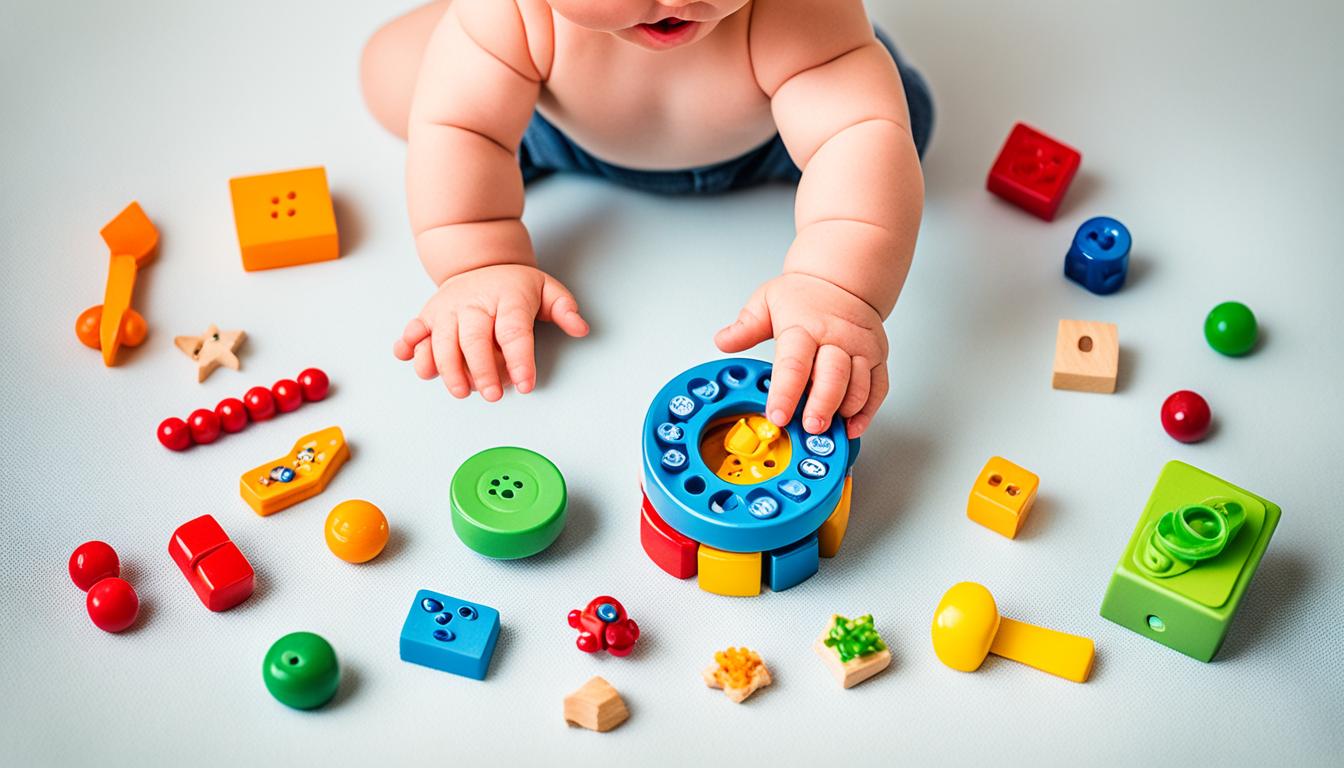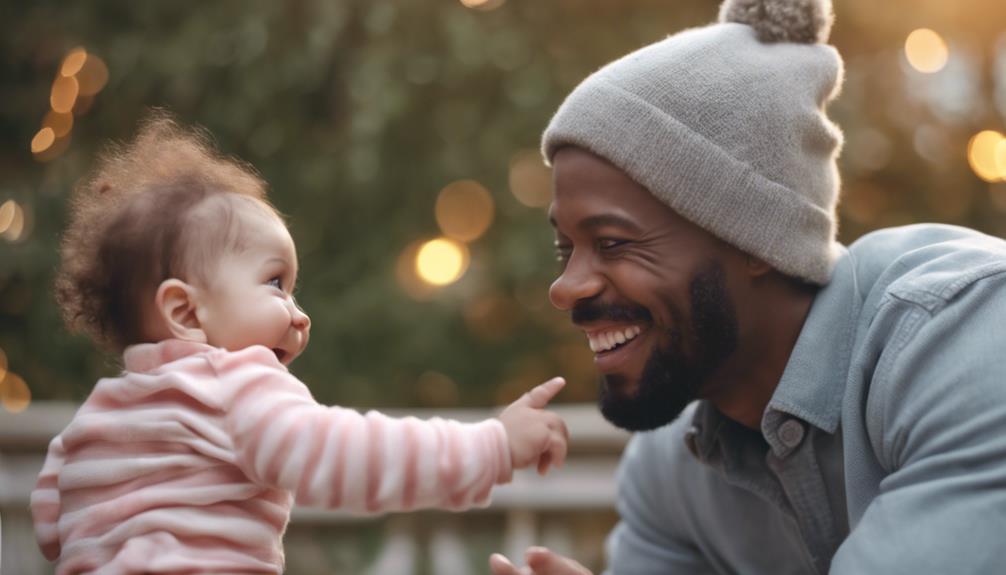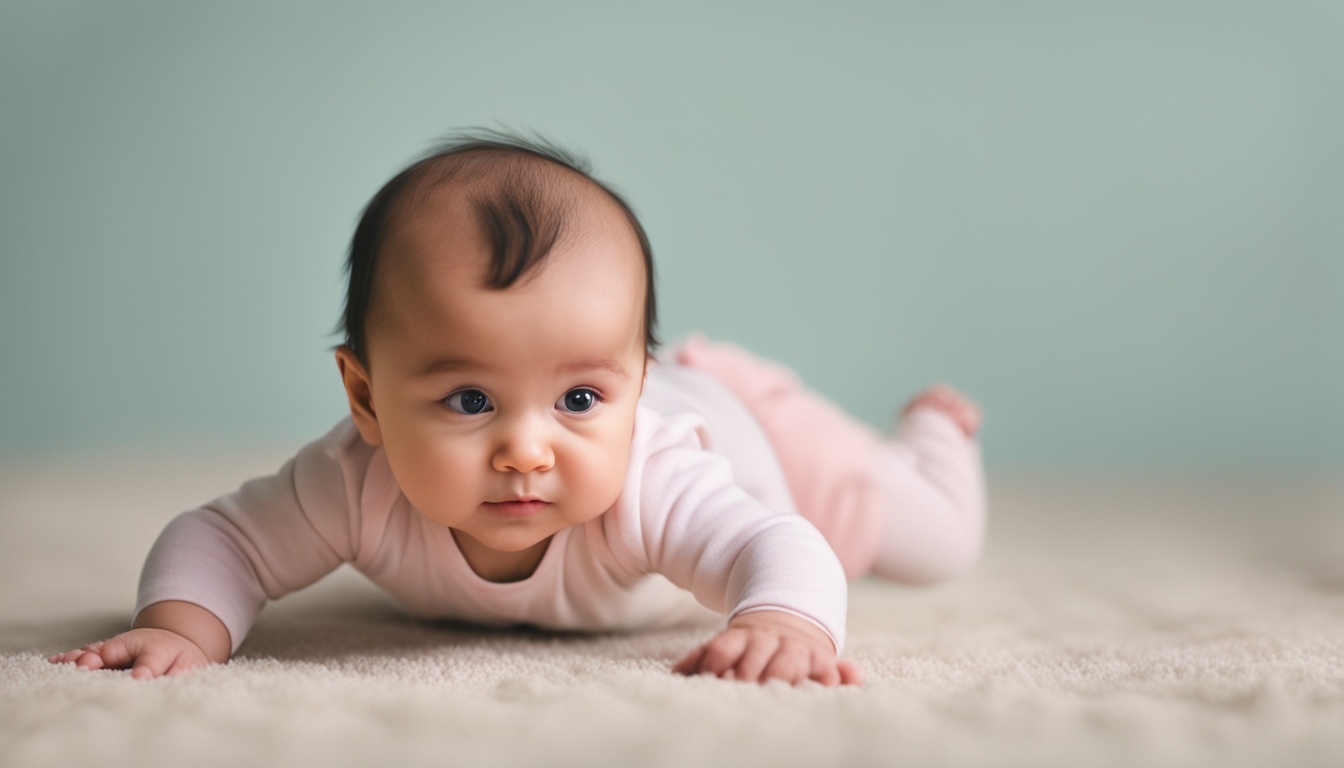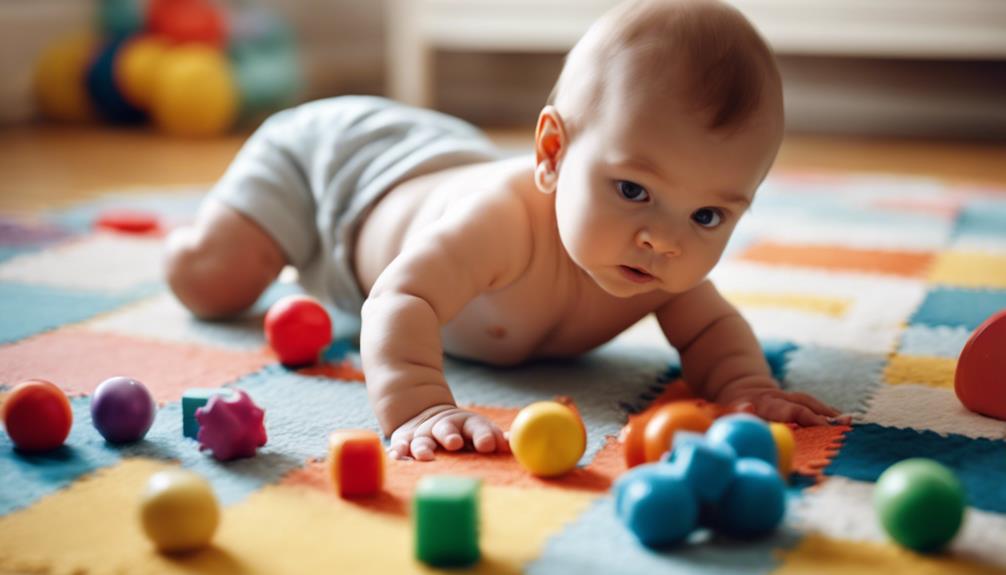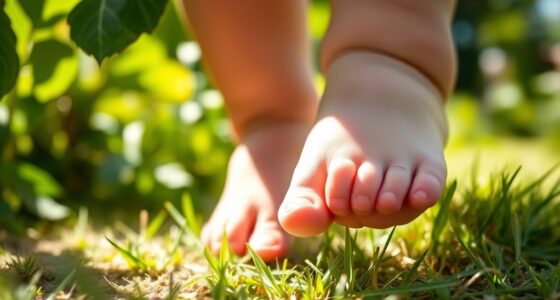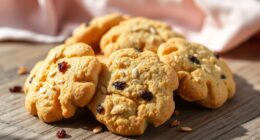Your child’s growth is an amazing adventure, marked by new findings and important achievements. As they mature and discover the world, fine motor skills are essential for their capacity to engage, study, and excel in daily tasks. These skills require coordination of small muscles in the hands, fingers, and thumbs, allowing your little one to do things like picking up objects, using utensils, and participating in play.
From the tender age of 0-3 months, babies begin their fine motor skills journey by bringing hands to mouth, moving arms, and swinging arms at toys. As they reach 3-6 months, they gain the ability to hold small objects without tucking thumbs, reach for toys with both arms, and push up on their arms while on their tummy. Holding hands together and following objects with their eyes in all directions further strengthen their developing skills1.
As your baby enters 6-9 months, they continue to progress, learning to shake and bang rattles, bring toys to their mouth, and use a raking grasp to explore their surroundings. They begin transferring objects between their hands, picking up small foods, and keeping their hands open and relaxed most of the time1. With each passing month, their fine motor skills become more refined.
By 9-12 months, children start demonstrating impressive achievements in their fine motor skills. They voluntarily release objects, give toys to caregivers when asked, and even engage in creative play by banging two toys together or turning the pages of a book. They can put objects into a container, point to objects, stack blocks, and wave goodbye1.
As your baby reaches 12-18 months, their fine motor skills continue to flourish. They develop the ability to clap hands, put objects into containers, and wave goodbye with excitement. Using both hands to play, isolating their index finger with other fingers closed, and scribbling with a crayon are just a few of their newfound skills. They may even begin using a spoon and cup, showcasing their growing independence1.
As the months go by, from 18-24 months, your little one’s fine motor skills blossom further. They can build block towers using multiple blocks, put rings on a ring stacker, turn book pages one at a time, and hold crayons with their fingertips and thumb. These achievements signify their growing dexterity and control over their hand movements1.
Milestone by milestone, your baby’s fine motor skills continue to progress, shaping their ability to interact and engage with their environment. It is essential to remember that each baby develops at their unique pace. Encouraging physical movement and providing opportunities for play and exploration are key in fostering fine motor skills development2.
Key Takeaways:
- Nurturing your baby’s fine motor skills enhances their ability to interact, learn, and perform everyday activities.
- Fine motor skills involve the coordination of small muscles in the hands, fingers, and thumbs.
- From 0-3 months, babies begin bringing hands to mouth and moving their arms, while at 3-6 months, they can hold objects and reach for toys with both arms1.
- Between 6-9 months, babies learn to shake and bang rattles, use a raking grasp, and transfer objects between their hands1.
- By 9-12 months, children begin voluntarily releasing objects, stacking blocks, and pointing to objects1.
What Are Fine Motor Skills?
Fine motor skills refer to the movement and use of the hands and upper extremities, including activities like reaching, grasping, and manipulating objects. These skills also involve hand-eye coordination and visual motor skills, which are necessary for coordinating the movements of the hands, legs, and the rest of the body. Fine motor skills focus on the smaller muscles, while gross motor skills involve the larger muscles.+
Babies and toddlers need plenty of playtime and practice to develop the small muscles required for fine motor control. As they progress through the developmental milestones, they start by bringing hands to their mouth, moving their arms, and swinging their arms at toys. Between 3-6 months, they begin to hold small objects in their hands, reach for toys with both arms, push up on their arms while on their tummy, and hold a toy like a rattle1. By 6-9 months, they are shaking and banging rattles, bringing toys to their mouth, using a raking grasp, and transferring objects between their hands1. Between 9-12 months, they start to release objects voluntarily, give toys to caregivers when asked, bang two toys together, turn pages of a book, and begin putting objects into containers1. At 12-18 months, they develop fine motor skills like clapping hands together, putting objects into containers, waving goodbye, isolating the index finger, scribbling with a crayon, and using a spoon and cup1. By 18-24 months, milestones may include building a block tower, putting rings on a stacker, turning book pages one at a time, and holding crayons with fingertips and thumb1.
Infant development also highlights the importance of “tummy time” for motor skill development. Prone or stomach lying aids in postural control, stability for hands and fingers, and foundational fine motor skills1. Proper visual skills development can be fostered by positioning faces about 12″ from the baby, choosing appropriate colors for visual stimulation, and exposing babies to varying visual environments1. Sensory skills can be developed by incorporating multiple senses through touch, movement, body awareness, sight, smell, hearing, and taste. Providing varied tactile experiences and sensory stimuli such as massage contribute to the development of fine motor skills in infants1.+
Incorporating occupational therapy can address developmental challenges in cognitive, daily living, motor, sensory processing, social, and visual/perceptual skill development. It offers comprehensive assessments and tailored therapeutic activities for each child’s unique needs1.
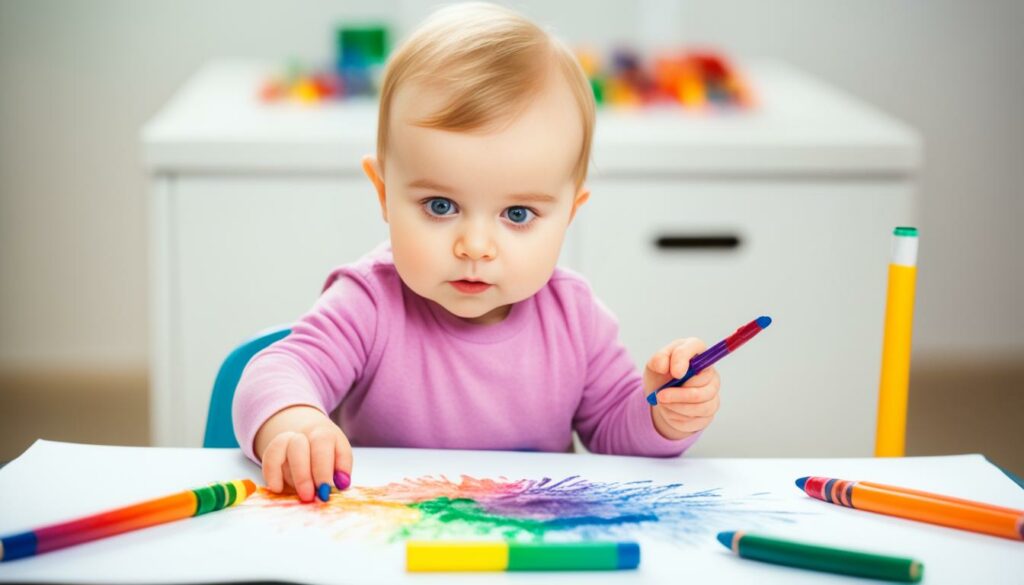
Activities to Improve Fine Motor Skills in Babies
Enhancing your baby’s fine motor skills is crucial for their overall development. Fine motor skills involve the coordination and control of small muscles in the hands and fingers, allowing them to perform everyday tasks like grabbing objects, using utensils, and playing. By engaging in specific activities, you can support the development of these skills at different stages of your baby’s growth.
For newborns, it’s essential to encourage hand movements by placing colorful toys within their reach. This stimulates their curiosity and helps them explore different textures. Providing soft rattles and teething toys that are easy to grasp can further enhance their hand-eye coordination and fine motor control3.
As your baby grows, you can introduce activities that require grasping and holding objects. Stacking cups and shape sorters are excellent choices as they promote hand-eye coordination, problem-solving skills, and the development of finger muscles4. Let your baby practice reaching for objects and transferring objects from one hand to the other. These activities help them become more skilled at manipulating objects, strengthening their fine motor skills3.
An important milestone in fine motor development is the ability to pick up age-appropriate finger foods like Cheerios. Encourage your baby to practice this skill, as it helps refine their pincer grasp and finger control3. Additionally, activities like squeezing objects, using the index finger to touch things, clapping hands, and banging items together promote further fine motor development3. These activities not only strengthen their hand muscles but also improve their hand-eye coordination and tactile sensitivity.
Another fun way to support your baby’s fine motor skills is through tummy time. This essential activity helps strengthen the core muscles that provide stability for fine motor control. By placing your baby on their tummy, they engage their arms and hands to push up, reach for toys, and explore their surroundings3.

Remember, each baby develops at their own pace, so it’s essential to allow them to explore and practice fine motor skills in a safe and supportive environment. By offering a variety of age-appropriate toys and engaging in activities that stimulate their hand and finger movements, you can help strengthen their fine motor skills and support their overall development4.
| Age | Activity |
|---|---|
| 0-3 months | Practicing grasping and swatting at objects, using toys like O balls and teething toys |
| 3-6 months | Exploring with bead mazes, scarves in tissue boxes, and introducing sign language. Responding to music and banging on pots and pans |
| 8-10 months | Engaging in activities like shape sorters, finger painting, puzzles, and object permanence boxes to promote pincer grasp development |
| 9-12 months | Playing with play dough, puzzles, musical instruments, and practicing self-feeding with puffs or rice rusks |
Encouraging fine motor skill development through engaging activities from an early age can significantly impact your baby’s overall development and skills acquisition. By providing them with the opportunity to practice and refine their fine motor skills, you are setting a solid foundation for their future growth and success4.
Fine Motor Skills Toys for Babies
Enhance your baby’s fine motor skills with a variety of engaging toys designed to promote hand-eye coordination, problem-solving, and sensory exploration. These toys provide opportunities for grasping, manipulation, and the development of fine motor control. Choose from a range of options that cater to different developmental stages and interests. Here are some fantastic toys to consider:
1. Rattles
Rattle toys are more than just fun noisemakers. They also play a vital role in the development of your baby’s grasp reflex, movement understanding, and auditory perception5.
2. Stacking Toys
Stacking toys are excellent for enhancing fine motor skills, eye-hand coordination, depth perception, and spatial perception5. Fisher-Price Rock-A-Stack stacking rings, for example, provide a colorful and interactive way for babies to practice their stacking and grasping abilities6.
3. Shape Sorters
Shape sorting toys are ideal for developing problem-solving skills and fine motor control. Melissa & Doug Shape Sorting Cube is a popular choice that encourages your baby to match shapes and manipulate objects6.
4. Sensory Balls
Textured balls, like those found in the Infantino Textured Multi Ball Set, offer a tactile experience that helps in fine motor skills development, hand-eye coordination, and sensory exploration5. Babies can grasp, squeeze, and roll these balls while engaging their senses6.
5. Activity Gyms
Activity gyms provide a stimulating environment for babies to practice reaching, grabbing, and batting at hanging toys. This type of play promotes fine motor skills development and encourages sensory exploration5.
6. Bath Cups
Bath cups are not only for splashing water; they also aid in fine motor skills development. Babies can use these cups for filling, pouring, and measuring practice, introducing concepts like more and less5.
7. Sensory Teethers
Teething toys, such as the Manhattan Toy Winkel Rattle & Sensory Teether Toy, not only provide relief during the teething process but also support fine motor skills development through grasping and manipulating the toy’s various textures6.
8. Building Blocks
Building blocks, like Mega Bloks First Builders Big Building Bag, encourage fine motor skills development and hand-eye coordination as babies discover how to connect, stack, and build different structures6.
9. Bead Mazes
Bead mazes, such as the Melissa & Doug First Bead Maze, offer babies the opportunity to manipulate colorful beads along twisting wires. This activity helps improve fine motor skills, hand-eye coordination, and concentration6.
By providing your baby with a variety of fine motor skills toys, you can support their development while fostering their curiosity and creativity. Remember to choose age-appropriate toys and supervise playtime for a safe and enjoyable experience. With these toys, your baby can embark on a fulfilling journey of fine motor skills exploration and growth.
Milestones for Fine Motor Skills in Babies
As your baby grows and develops, they will reach specific milestones for fine motor skills. These milestones indicate their progress in using and controlling their hands and fingers. It’s important to track these milestones to ensure your baby’s fine motor skills are developing as expected.1
From birth, babies automatically grasp and hold onto objects, a fundamental skill in fine motor development. By three months, they can start grasping objects that are placed in their hand, showing an improvement in their ability to control their grip.1
Between four to six months, babies begin picking up toys with both hands, using their palms to grab objects. This milestone represents their growing dexterity and coordination.1
As they approach their first birthday, babies achieve more advanced milestones. They can pick up dropped objects, grasp and release objects in a controlled manner, and use their thumb and one finger to pick things up. These milestones showcase their developing fine motor control and precision.1
By observing these milestones, you can ensure your baby’s fine motor skills are developing within the expected timeframe. Remember that each baby is unique and may reach these milestones at slightly different times. If you have any concerns about your baby’s fine motor skills development, consult with your healthcare provider for guidance and support.
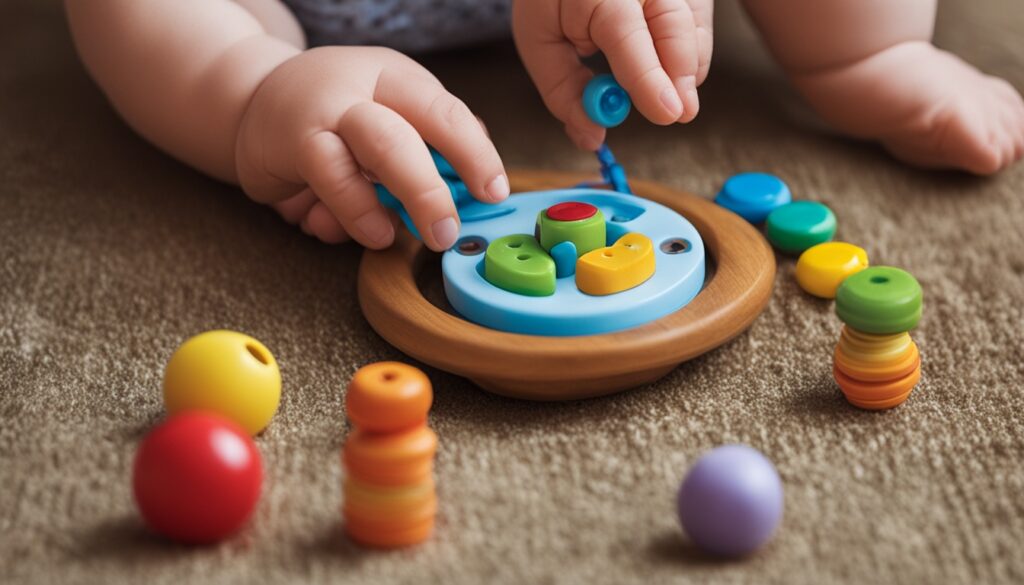
| Age Range | Developmental Milestones |
|---|---|
| 0-3 months | Babies bring hands to mouth, move arms, may swing arms at toys, and hands start to open more for fine motor development.1 |
| 4-6 months | Babies start picking up toys with both hands and use their palms to grab objects.1 |
| 7-12 months | Babies can pick up dropped objects, grasp and release objects in a controlled manner, and use their thumb and one finger to pick things up.1 |
Tracking these milestones provides valuable insights into your baby’s fine motor development. Celebrate each milestone they achieve and continue to engage them in activities that promote their fine motor skills growth. Remember to consult with your healthcare provider for any concerns or questions you may have throughout this exciting journey.
Importance of Fine Motor Skills Development in Babies
Fine motor skills development is crucial for your baby’s everyday activities and future success. The ability to manipulate objects, hold utensils, and perform self-care tasks like dressing and feeding rely on fine motor skills1. These skills also contribute to cognitive development, as they involve problem-solving, coordination, and attention to detail. Fine motor skills allow babies to explore the world around them and engage with different objects and materials1. They promote independence and boost self-confidence as babies gain control over their movements1. Supporting fine motor skills development sets a strong foundation for future learning and ensures your baby is equipped with the necessary skills for various tasks and activities1.
Fine Motor Skills Activities for Newborns
While newborns have limited motor control, there are activities you can engage in to promote their fine motor skills development. By providing opportunities for sensory play and gentle stimulation, you can help your newborn strengthen their fine motor skills and lay a foundation for future development.
1. Exploring Different Textures
One way to stimulate your newborn’s fine motor skills is by softly touching their hands with different textures and surfaces. Gently stroking their hands with soft fabrics or letting them feel various textures helps them become familiar with different sensations1.
2. Encouraging Grasping and Finger Movements
Placing objects within your newborn’s reach can encourage grasping and finger movements. Consider offering fabric toys or small rattles that they can touch and hold onto. This helps them develop hand-eye coordination and practice their grip1.
3. Sensory Play
Sensory play can be beneficial for both sensory and fine motor development in newborns. Rubbing a balloon against their hands or feet allows them to experience different textures and sensations while also improving their sensory processing abilities1.
Remember to always supervise your newborn during playtime, and ensure that the toys and activities are age-appropriate and safe. Providing opportunities for sensory exploration and gentle stimulation can support your baby’s fine motor skills development, even in their earliest months
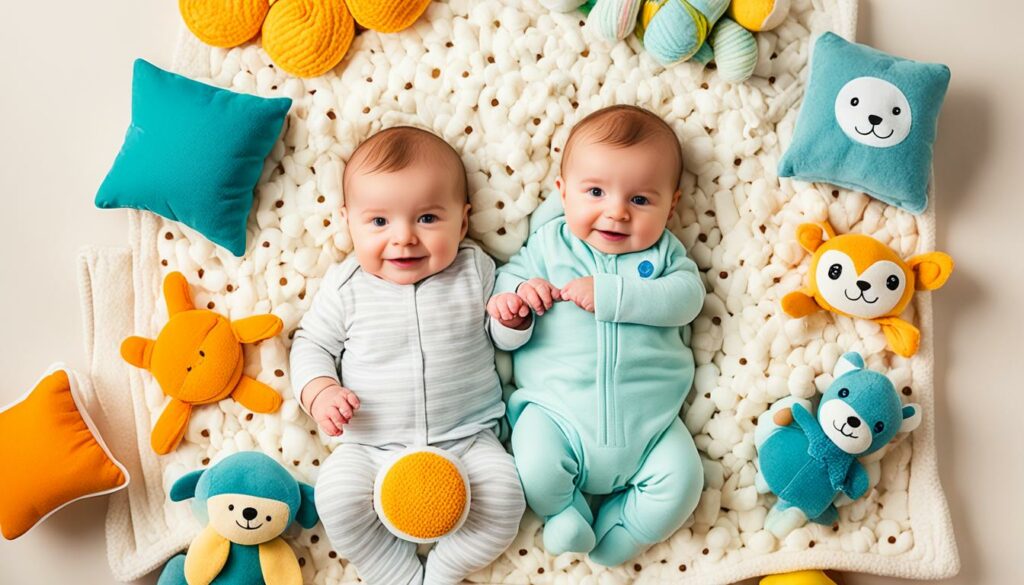
The Role of Vision in Fine Motor Skills Development
Vision plays a significant role in the development of fine motor skills. Visual motor skills, also known as hand-eye coordination, are crucial for coordinating the movements of the hands and the rest of the body, allowing babies to interact with their environment. By stimulating your baby’s vision, you can support their fine motor skills development.
One way to stimulate your baby’s vision is by using toys with bright colors and contrasting patterns. These visual stimuli capture their attention and encourage them to focus on and track objects, promoting hand-eye coordination and visual motor skills.
Additionally, getting close to your baby’s face and making expressive facial expressions can engage their visual skills. Making eye contact and using exaggerated facial gestures not only attract your baby’s attention but also encourage them to visually track your movements, supporting the development of hand-eye coordination.
Exposing your baby to different visual environments is another way to promote visual development and fine motor skills. Varying their surroundings and offering different views can help them develop a broader range of visual skills, such as depth perception and object recognition.
The integration of visual stimuli is an essential aspect of fine motor skills development. By promoting visual motor skills and hand-eye coordination through engaging visual experiences, you are laying the foundation for your baby’s future fine motor abilities.
Conclusion
Developing fine motor skills is an essential aspect of your baby’s growth and development. By engaging in activities and providing appropriate toys that support fine motor skills, you can help improve your baby’s hand and finger muscles and enhance their ability to manipulate objects8. Studies have shown that strong fine motor skills are correlated with academic success in school and better hand-eye coordination8. Encouraging the development of fine motor skills through activities like drawing, craft-making, and playing with small toys is crucial for your child’s future success8.
Participating in physical activities, such as dancing and swimming, can also aid in reaching developmental milestones related to motor skill development9. Limiting screen time and prioritizing physical play have been linked to increased engagement in physical activities and overall physical and cognitive development9. Engaging in outdoor activities or sports at least three times a week can result in significant improvements in motor skill development9. Additionally, having a balanced approach to screen time and physical play can lead to increased confidence and self-esteem, positively impacting motor skills development9.
Fine motor skills involve coordinating small muscles in the wrist, hand, fingers, and toes, while gross motor skills encompass larger muscle movements in the arms, legs, and feet10. Each child progresses at their own pace in fine motor skills development, from clenching hands in the first months to handling tools like child-safe scissors by age three10. Activities like stacking blocks, playing with pegboards, and coloring can assist in the development of fine motor skills10.
As you observe your baby’s milestones and promote fine motor skills development, it’s important to consult with pediatricians or occupational therapists if you have any concerns or notice any delays8. Enjoy the exciting journey of watching your baby’s fine motor skills flourish and the impact it will have on their daily activities and future learning!
FAQ
What are fine motor skills?
How can I improve my baby’s fine motor skills?
Are there toys that can help develop my baby’s fine motor skills?
What are the milestones for fine motor skills in babies?
Why is fine motor skills development important for babies?
What activities can I do to improve fine motor skills in newborns?
How does vision impact fine motor skills development?
Source Links
- https://www.chrichmond.org/services/therapy-services/developmental-milestones/fine-motor-skills-birth-to-2-years
- https://pathways.org/topics-of-development/motor-skills/
- https://thewarrencenter.org/help-information/fine-motor/fine-motor-activities-for-infants/
- https://reachformontessori.com/how-to-improve-fine-motor-skills-in-babies/
- https://bibsworld.com/blogs/guides/the-best-toys-to-improve-babies-fine-motor-skills
- https://www.whattoexpect.com/baby-products/toys/fine-motor-skills-toys/
- https://www.ncbi.nlm.nih.gov/pmc/articles/PMC9790241/
- https://littleplayhouse.com.my/development-of-fine-motor-skills/
- https://kidscarehomehealth.com/motor-skill-development-a-comprehensive-guide/
- https://www.pampers.com/en-us/baby/development/article/baby-fine-motor-skills

